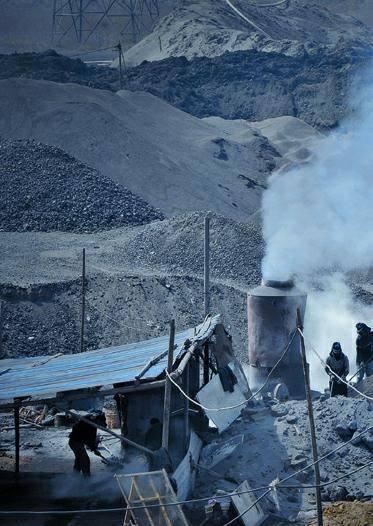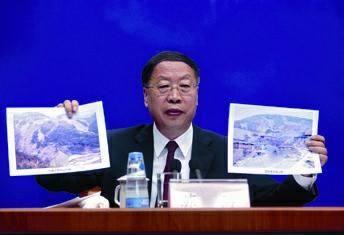Rare Earth Resolution
By Lan Xinzhen



Inner Mongolias Dalahai Village was a place of utopian beauty. With a landscape of lush green hills, exuberant grasslands and herds of sheep and cows, the village used to be the quintessential image of a nice place to live.
Today, the quaint village is gone, replaced by a barren landscape void of life. Cancer cases among the remaining local populace have been on the rise.
Whats the reason for the cataclysmic change? Li Guirong, a Dalahai villager, puts the blame on the discovery of rare earths.
“We knew something was wrong sometime in the late1980s when the trees and local vegetation blossomed but didnt bear any fruit,” Li said.“Later, they stopped growing at all.”
Rare earths, a group of 17 elements, are valuable, non-renewable resources essential in the manufacture of a range of hi-tech products, including wind turbines, laptops and hybrid cars.
China has the richest rare earth reserves in the world, with Baotou in the north and Ganzhou in the south as major reserve zones.
Growing awareness of the dangers of mining rare earths has galvanized the Central Government to act.
At a press conference addressing new government measures to control errant rare earth mining operations, Su Bo, Vice Minister of Industry and Information Technology(MIIT), outlined a series of new government regulations to rein in the sector.
In March, a team led by Su took an inspection tour of a rare earth exploitation site in Ganzhou, Jiangxi Province. The team was shocked by the environmental pollution and the cost to clean up the area, a whopping 38 billion yuan ($5.97 billion).
“China shoulders 95 percent of global rare earth output, at the cost of polluting its environment. This needs to change,” said Su.
Disputes on the rise
To improve the local ecological environment, the Chinese Government began to take restrictive measures two years ago, intensifying control over the exploitation, processing and export of rare earth.
Nevertheless, Chinas regulation on rare earth triggered groundless opposition from the European Union, the United States and Japan. On March 13, the trio lodged a joint complaint to the WTO, accusing China of breaking WTO rules on rare earth exports. On July 27, the three turned to the WTOs dispute-settlement system to have an expert panel investigate the issue.
The United States, EU and Japan said Chinas exports controls, including export quotas and export tariffs, unfairly favor Chinas domestic manufacturers.
Shen Danyang, spokesman of Chinas Ministry of Commerce (MOFCOM), says differently.
“China has reiterated that curbing rare earth mining operations and output was done for the sole purpose of protecting the environment. We didnt mean to protect domestic industry by twisting trade,” said Shen. “This is going to take time and were going to face a lot of pressure, but were going to fight this to the end.”
Reasons for friction
Although China has emphasized that its export management measures are designed for environmental protection and sustainable development, foreign buyers continue to oppose the controls.
“Their goal is to continue importing cheap rare earth from China,” said Gao Yunhu, Deputy Director of the Rare Earth Office under the MIIT.
The United States has its own rare earth reserves but has shut down most rare earth mines. The EU lacks rare earth and relies on China to supply its demand. Japan hopes to import rare earth minerals at low prices to maintain its competitiveness in the hi-tech sector.
China is the worlds largest producer and exporter of rare earth, accounting for 95 percent of the global output but having only 36 percent of global reserves, according to the MIIT.
Spurred by surging international market demand, illegal mining and smuggling operations rampant in the rare earth sector have caused the price of the valuable resources to plunge. From 1990 to 2005, Chinas rare earth exports increased 10 fold, but prices nosedived 50 percent.
“Chinas regulation of the rare earth sector is totally consistent with WTO rules,” said Gao.“China treats domestic and foreign companies equally, and the price of rare earth should be adjusted by the market. China has synchronized management and regulation in all links, from exploitation to processing and finally to export.”
WTOs expert panel is designed to avoid unfair competition caused by trade distortions, said Ma Yu, Director of the FDI Department of the Chinese Academy of International Trade and Economic Cooperation under the MOFCOM.
“If China only has restriction on exports and foreign consumers have to pay a different price compared with domestic consumers, it is distorting the trade. But China has implemented restrictive measures in all links, from rare earth exploration and processing to exports. Those measures will have the same impact on both domestic and foreign buyers. For the same product, they pay the same price. This doesnt violate WTO rules because we have never twisted trade,” said Ma.
Chinas stance
Four measures will be taken to clear polluted areas around China. First, environmental requirements will be implemented in production, processing and exports and optimized entry criteria in rare earth exploitation established. Second, the environment protection standard will be enhanced and any company that fails to meet those standards within a required period of time will be shut down. Third, an overall environment check will be conducted. Up to now, a list of 56 qualified rare earth production companies has been released. Finally, more advanced production technology will be adopted to continuously improve the whole sectors production level, according to Su.
China will continue its rare earth supply to the world when intensifying efforts in resource and environmental protection. China also hopes other countries with rare earth resources shoulder their due responsibility in global rare earth supplies, said Su.
“Opening up the rare earth sector is the existing policy. We will follow a win-win strategy of maintaining a reasonable amount of rare earth supply to the international market, while at the same time protecting the environment and resources,” said Su.
Su also said that China will continue to encourage foreign investment in the sector. Thus far, the United States, Germany, France, Canada and Japan have set up 38 wholly owned or jointly funded rare earth companies in China.
“As the next step, we will encourage foreign investment in environment restoration, recycling and reuse of rare earth wastes, as well as in manufacturing of rare earth processing equipment. This will help enhance Chinas ability in protecting the environment and resources when exploring and processing rare earth.”
MIIT and MOFCOM will continue international communication to clarify Chinas stance on this issue. China has never intended to gain any economic or political benefits with such a minor sector as the rare earth. It will accelerate coordination with other rare earth producing and consuming countries to solve resource and environmental problems facing the sector.
“We hope to facilitate continuous improvement of rare earth technology around the world,” said Su.
Meanwhile, China will refuse to loosen its regulations on the sector. Dealing with rare earth pollution is a major problem that the Chinese Government is facing when tightening regulations. On August 6, the MIIT released the Entry Criteria of the Rare Earth Sector, rectifying the sector from production scale, processing technology and energy efficiency. Its widely estimated that 20 percent of the production capacity will be phased out.
Reflection
Whether China can win the WTO dispute remains to be seen.
Chinas restriction on rare earth production and export is meant to protect the environment, a move that is accepted under WTO rules, said Song Hong, head of the Department of International Trade at the Chinese Academy of Social Sciences.
“But the United States, EU and Japan claimed that rare earth was not among the list of Chinas export control products when China entered the WTO. This is quite disadvantageous for China. China promised to impose a tariff on 84 products during its WTO entry, but rare earth is not among them,” said Song.
China will continue its regulation on the sector whether it wins or loses in the trade friction. Shutting down polluting exploration and processing factories will inevitably restrict its rare earth exports. For China, the important issue isnt in winning or losing the appeal but in reflecting why the rare earth regulation has triggered such an international dispute.
“The essential problem lies in the production link. We should reflect on why we failed in rectifying such a small sector after years of efforts,” said Tu Xinquan, Deputy Director of the WTO Research Center under the University of International Business and Economics.
Although China has exploration and smelting quotas each year, illegal mining and illicit extraction of rare earth resources and smuggling of rare earth products through bypassing the export quota system are common problems in the sector because we lost control of the source, said Tu.
In order to control the source of the whole sector, China should initiate a strategic plan on rare earth exploitation and a general layout for its further development. Moreover, the country should enhance the approval threshold for strategic resources, such as rare earth minerals, said Tu.
Any mines approved before that are not in line with relevant government policies and regulations should be shut down. Industrial integration is the key. After integrating the currently fragmented industry, industrial behemoths will have the sense and ability to control productivity and prices, even without government restriction and supervision, said Tu.
Similar practices are quite common in other countries, such as the iron ore industry in Brazil and Australia. They enjoy a very high industrial concentration ratio and their exports rely heavily on price control, but they seldom receive lawsuits, said Tu.

